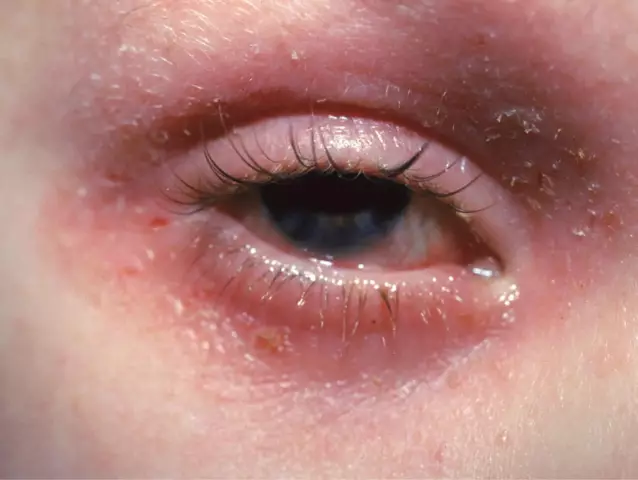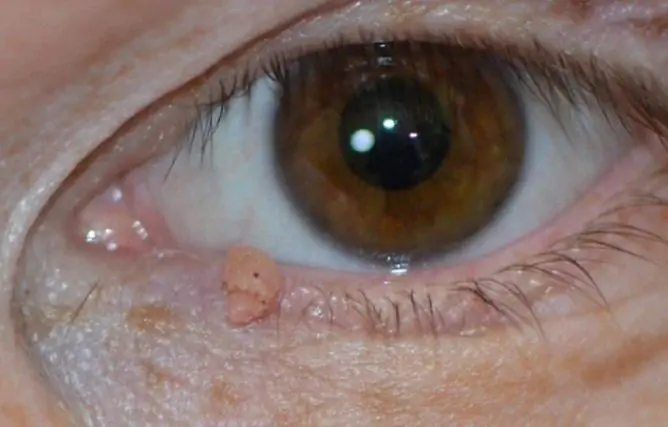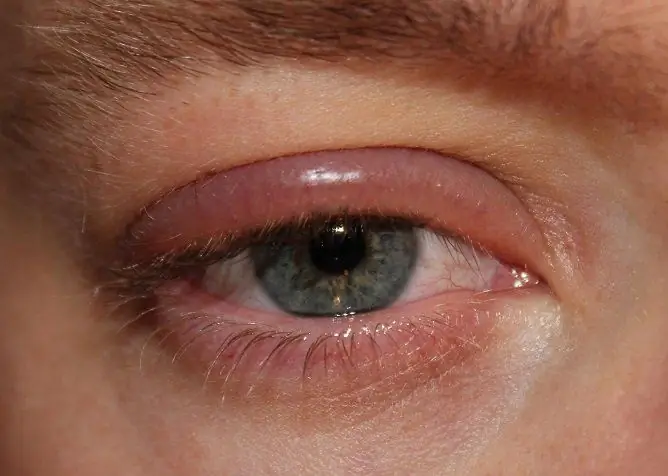- Author Rachel Wainwright [email protected].
- Public 2023-12-15 07:39.
- Last modified 2025-11-02 20:14.
Inflammation of the eyelid

Inflammation of the eyelid is an inflammatory process of various etiologies that occurs on the upper, lower eyelids or affects both eyelids. The symptoms of inflammation of the eyelid are different: itching, redness, swelling. The main causes of inflammation of the eyelid are barley (inflammation of the meibomian glands of the edge of the eyelid), abscess of the eyelid (abscess of the eyelid), blepharitis (inflammation of the edge of the eyelid), herpes infection.
Barley is an acute purulent inflammatory process of the hair follicle of the eyelash or sebaceous gland, the duct of which flows into its bag. The main cause of the development of the disease is Staphylococcus aureus. Barley also has the name meibomite - a purulent staphylococcal inflammatory process of the meibomian glands. Barley can be single or multiple. The development of inflammation of both the upper and lower eyelids, one or both eyes can be observed.
Symptoms of inflammation of the eyelid with meibomitis:
- Swelling, redness;
- Swelling of the eyelid;
- Tenderness to palpation;
- Purulent discharge from the top of the swelling.
With such inflammation of the eyelid, treatment is reduced to local cauterization of the inflamed area of the eyelid with 70% ethyl alcohol or a brilliant green solution.
An abscess of the eyelid is an abscess caused by an infection in the wound surfaces of the eyelid skin. Often, this inflammation of the eyelid is a consequence of the spread of a purulent process from barley. Another common cause of inflammation of the upper eyelid (also the lower one) is purulent processes occurring in the surrounding tissues - the paranasal sinuses, orbit. The most common causative agent of eyelid abscess is staphylococcus aureus.
Symptom of inflammation of the eyelid with an abscess:
- Eyelid enlargement, swelling of its area;
- Redness of the eyelid;
- Acquisition of a yellowish conjunctiva;
- Pain in the eye area, eyelid;
- Severe headaches.
With such inflammation of the eyelid, treatment involves the use of antibiotics, elimination of the main cause of the development of an abscess, and physiotherapy. In extreme cases, with purulent fusion, surgical intervention is necessary.

Herpetic inflammation of the eyelid is caused by the herpes simplex virus (Herpes Simplex) and the herpes zoster virus (Herpes Zoster). The disease affects both the upper and lower eyelids, bubbles form on the skin of the eyelids, filled with watery contents. During the course of the disease, the contents of the vesicles become cloudy, the vesicles open, after which the affected areas of the eyelid heal, becoming covered with epithelium. The course of the disease is complicated by severe itching, with mechanical damage to the vesicles, the virus spreads and further tissue damage. The inflammatory process is accompanied by moderate painful sensations. Herpes viral infection is recurrent.
Blepharitis is the most common cause of inflammation of the eyelid.
Inflammation of the upper eyelid (lower eyelid): blepharitis, symptoms, types of disease
Blepharitis is an inflammatory process of the edge of the eyelid. The main reasons for the development of blepharitis include the weakening of the body's protective functions, chronic infections, pathologies of the gastrointestinal tract, sanitary and hygienic conditions of human life, vitamin deficiency, purulent inflammation of the paranasal sinuses.
The main symptoms of blepharitis are:
- Burning, redness of the eyelid;
- Feeling of a foreign body in the eye;
- Foamy or purulent discharge.
Other specific symptoms are characteristic of certain types of disease.
There are the following types of blepharitis:
- Demodicous - the causative agent of this type of inflammation of the lower eyelid (as well as the upper one) is the Demodex mite, which lives in the eyelash follicles. Infection with a tick occurs from birds, down or feathers in bedding;
- Scaly - this type of blepharitis is also called seborrhea. The characteristic symptoms for this type of inflammation of the upper eyelid (lower) are narrowing of the palpebral fissure, the formation of gray, white, yellowish scales, like dandruff, at the base of the eyelashes, severe painful itching, increased sensitivity to light, dust, wind;
- Ulcerative - this type of inflammation of the lower eyelid (upper) is one of the most complex forms of the disease. It is characterized by pronounced painful sensations, as well as the formation of ulcers along the eyelash growth line. In some cases, there is spotting from the affected areas of the eyelid. The process is accompanied by the loss of eyelashes;
- Angular - angular blepharitis is characterized by the localization of the inflammatory process in the corners of the palpebral fissure with the accumulation of foamy contents;
- Meibomian - inflammation of the eyelid, in the process of which not only the skin areas of the eyelid are involved, but also the meibomian glands. The inflammatory process is characterized by yellowish-white discharge, the formation of crusts, the accumulation of foamy-purulent contents in the corners of the eyes. Often this inflammation of the eyelid is accompanied by conjunctivitis.
How to identify inflammation of the eyelid in a child
Inflammation of the eyelid can develop in children. The highest risk groups are preschoolers and schoolchildren. The main reason for the development of inflammation of the eyelid in a child is poor hygiene. It is possible to reveal inflammation of the eyelid in a child even at the initial stage, when the child does not complain of painful, unpleasant sensations. So, inflammation of the eyelid in a child is manifested by frequent blinking, lacrimation. The child often rubs the eye. In infants with inflammation of the eyelid, frequent blinking, lacrimation, crying, refusal to eat are observed. If an inflammatory process of the eyelid is detected in a child, it is necessary to immediately consult a doctor.
Inflammation of the eyelid: treatment, prevention
With inflammation of the eyelid, treatment is aimed at eliminating the causes of the development of the inflammatory process. In many cases, symptomatic treatment is prescribed to patients. The main place in the treatment of inflammation of the eyelids (blepharitis of various etiologies in particular) is eyelid hygiene. To suppress the inflammatory process, local antibiotics are prescribed: ointments, drops. With ulcerative, scaly blepharitis, regular treatment of the affected areas of the eyelid is necessary to eliminate scales and purulent discharge.
Prevention of the development of inflammation of the eyelid involves maintaining personal hygiene, improving nutrition, maintaining immunity, and maintaining a healthy lifestyle.
YouTube video related to the article:
The information is generalized and provided for informational purposes only. At the first sign of illness, see your doctor. Self-medication is hazardous to health!






